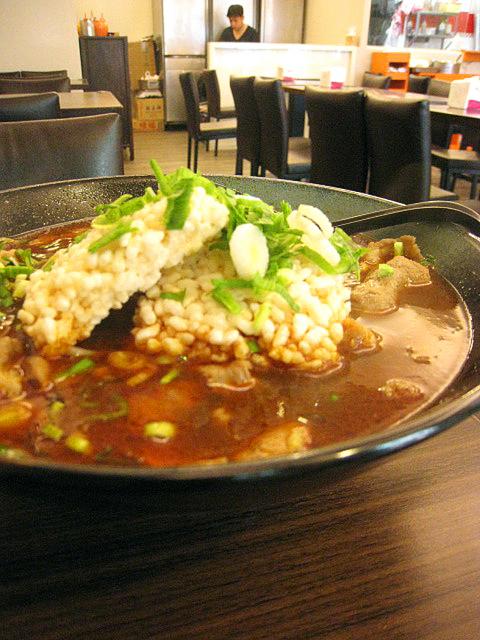With cold weather gradually settling in, thoughts turn to a good hot pot, particularly the sharp heat of chili and the tingle-inducing Sichuan pepper (Zanthoxylum piperitum).
Chili hot pots, or indeed any kind of hot pot, are best enjoyed in the company of three or four people, but such social gatherings are not always possible when the yen for fiery food hits.
One solution is a visit to Han Chi Tiger Noodles (韓記老虎麵食館), an establishment that opened nearly two decades ago and last year relocated to Jinhua Street on the fringes of the Yongkang Street shopping district.

Photo: Ian Bartholomew, Taipei Times
Han Chi’s tiger noodles (老虎麵), the house specialty, are appropriately named: they have a fierce bite.
The tiger noodles come in beef, chicken, mutton or pork, and are served with lamian (拉麵), vermicelli noodles (冬粉) or crispy rice (鍋巴), and in four levels of spiciness.
Whatever your choice, the bowl is NT$180.
I picked the third level of spiciness, expecting a lively number, but previous experience with spicy food in Taiwan prevented expectations from soaring too high.
Lashings of hot but otherwise flavorless chili oil and over-salted preserved chili sauce are the quick and easy way many a restaurant spices up its fare.
A mouthful of soup is often enough to see through the sham, for while the bowl of noodles is red and burns the tongue, there really isn’t that much going on flavorwise.
Han Chi’s tiger noodles are quite another proposition. The dish certainly lit a fire in my mouth, but beyond the burning there was a depth of flavor and layers of spiciness.
The quality of a good chili stock is like a fine wine, with the characteristics of different types of peppers working their way to the fore as you eat.
Having sampled tiger noodles in a number of combinations, the pork seems to work best as the meat is able to draw in the chili and impart some of its own flavor as well.
The quality of the noodles is excellent, but for something a little unusual, one version is served with blocks of crisp rice — something like savory Rice Krispies treats — that are excellent for soaking up rich sauces. Tiger noodles are served with jellied duck blood and tofu skin, both classic accompaniments. (The former can be omitted on request.)
Han Chi’s third level of spiciness exceeds anything in the “medium hot” category of many local restaurants — the fourth level should only be chosen by masochists. Sweat-soaked collars — even when the mercury dips — are far from a rare occurrence at Han Chi.
The restaurant offers many other dishes, not all of them so hot. Its clear beef broth (清燉湯麵, NT$90, or NT$150 with added beef, 清燉牛肉麵) is full of flavor, and its Sichuan-style fried sauce noodles (川式炸醬麵, NT$75) and shaoshao noodles (紹燒麵, NT$75) — a variation on the more typical dandan noodles (擔擔麵) — are both toothsome. Both rely for effect on the high quality of the noodles and a careful preparation of condiments, rather than on a chili bite.
The side dishes at Han Chi should not be neglected, with abalone mushrooms stewed in soy (NT$50) and stewed pig’s intestine (NT$100) deserving special mention for outstanding flavor and texture. A sweet mung bean soup is offered free of charge and is ideal for bringing down the internal temperature.

Most heroes are remembered for the battles they fought. Taiwan’s Black Bat Squadron is remembered for flying into Chinese airspace 838 times between 1953 and 1967, and for the 148 men whose sacrifice bought the intelligence that kept Taiwan secure. Two-thirds of the squadron died carrying out missions most people wouldn’t learn about for another 40 years. The squadron lost 15 aircraft and 148 crew members over those 14 years, making it the deadliest unit in Taiwan’s military history by casualty rate. They flew at night, often at low altitudes, straight into some of the most heavily defended airspace in Asia.

Beijing’s ironic, abusive tantrums aimed at Japan since Japanese Prime Minister Sanae Takaichi publicly stated that a Taiwan contingency would be an existential crisis for Japan, have revealed for all the world to see that the People’s Republic of China (PRC) lusts after Okinawa. We all owe Takaichi a debt of thanks for getting the PRC to make that public. The PRC and its netizens, taking their cue from the Chinese Communist Party (CCP), are presenting Okinawa by mirroring the claims about Taiwan. Official PRC propaganda organs began to wax lyrical about Okinawa’s “unsettled status” beginning last month. A Global

Taiwan’s democracy is at risk. Be very alarmed. This is not a drill. The current constitutional crisis progressed slowly, then suddenly. Political tensions, partisan hostility and emotions are all running high right when cool heads and calm negotiation are most needed. Oxford defines brinkmanship as: “The art or practice of pursuing a dangerous policy to the limits of safety before stopping, especially in politics.” It says the term comes from a quote from a 1956 Cold War interview with then-American Secretary of State John Foster Dulles, when he said: ‘The ability to get to the verge without getting into the war is

Like much in the world today, theater has experienced major disruptions over the six years since COVID-19. The pandemic, the war in Ukraine and social media have created a new normal of geopolitical and information uncertainty, and the performing arts are not immune to these effects. “Ten years ago people wanted to come to the theater to engage with important issues, but now the Internet allows them to engage with those issues powerfully and immediately,” said Faith Tan, programming director of the Esplanade in Singapore, speaking last week in Japan. “One reaction to unpredictability has been a renewed emphasis on